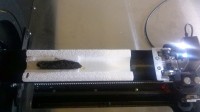 In 1970, an excavation of an ancient synagogue in the town of En-Gedi just west of the Dead Sea unearthed a parchment scroll. The town was inhabited from the late 8th century B.C. until it burned down in early 7th century A.D., and the scroll bore mute witness to En-Gedi’s fate. It was found inside the synagogue’s Holy Ark and was badly charred, so severely damaged that there was no way of unrolling it to read its contents. The lightest touch would cause the carbonized chunk to crumble. Radiocarbon dating determined the scroll dates to the 3rd or 4th century A.D.
In 1970, an excavation of an ancient synagogue in the town of En-Gedi just west of the Dead Sea unearthed a parchment scroll. The town was inhabited from the late 8th century B.C. until it burned down in early 7th century A.D., and the scroll bore mute witness to En-Gedi’s fate. It was found inside the synagogue’s Holy Ark and was badly charred, so severely damaged that there was no way of unrolling it to read its contents. The lightest touch would cause the carbonized chunk to crumble. Radiocarbon dating determined the scroll dates to the 3rd or 4th century A.D.
Forty-five years later in 2015, the Israel Antiquities Authority and University of Kentucky computer science Professor Brent Seales announced that high-resolution micro-computed tomography scanning and new virtual unwrapping software engineered by Seales and his crack team of students had been able to peer into the blackened, crispy scroll and read the first eight verses of the Book of Leviticus. That makes the En-Gedi scroll the oldest book from the Torah found since the discovery of the Dead Sea scrolls (1st century B.C. – 1st century A.D.) and the only ancient Pentateuchal book ever found in a Holy Ark.
 The noninvasive technology works by converting the 3D scans into 2D images on which the writing is legible. Computer algorithms partition the 3D scans into segments with writing on them. The surface is then rendered into a 3D model where all textures — writing, ink — are positioned exactly where they were they found in the original scan. From the 3D model a flattened 2D version of the surface texture is generated which unwraps the rolled up surface onto a flat page.
The noninvasive technology works by converting the 3D scans into 2D images on which the writing is legible. Computer algorithms partition the 3D scans into segments with writing on them. The surface is then rendered into a 3D model where all textures — writing, ink — are positioned exactly where they were they found in the original scan. From the 3D model a flattened 2D version of the surface texture is generated which unwraps the rolled up surface onto a flat page.
Since last year, Seales’ team has virtually unraveled five complete wraps of the parchment scroll. While the text itself is less than thrilling (they find one scroll and it has to be Leviticus?), the implications for future research are deeply exciting.
Besides illuminating the history of the biblical text, our work on the scroll advances the development of textual imaging. Although previous research has successfully identified text within ancient artifacts, the En-Gedi manuscript represents the first severely damaged, ink-based scroll to be unrolled and identified noninvasively.
The University of Kentucky team has worked on scrolls found at Herculaneum that were carbonized in the eruption of Vesuvius that destroyed the town and its better known neighbor Pompeii, but that was four years ago and they were only able to pick out a single blurry unidentifiable letter. I dearly hope they give it another try now.
This video explains the virtual unwrapping process and how it worked on the En-Gedi scroll.
[youtube=https://youtu.be/GduCExxB0vw&w=430]
The full study replete with technical details has been published in Science Advances and can be read in its entirety here.